In the watch industry (and in commentary about the industry), there seems to be a bit of competition regarding terms that describe micro brands and independent watchmakers and what defines these terms.
On Quill & Pad we have published articles from various contributors arguing a position or explaining the nuance of what independent watchmaking means today (see Big Brand Investments In Independents: Sellout Or Salvation? by GaryG and Independent Watchmaking: A New Trend Or Just A Trendy Term by Ashton Tracy).
The terms are contentious, it seems, as people feel the need to define everything as a way to categorize and ascribe value.
For a consumer or collector, this isn’t an unneeded practice, though: spending large amounts of money on something requires a thorough understanding of the intended purchase. Knowing whether or not something is a micro brand or an independent watchmaker can make a huge difference to a person’s willingness to spend $1,000 or a $100,000 on a timepiece.
But when the prices fall below $10,000 (and yes, I know this is a lot of money), the difference between whether a brand is a micro brand or an exclusive independent watchmaker doesn’t matter as much in the long term.
With a few exceptions, watches are generally terrible investments. So purchasing a watch, especially an entry level watch (i.e., under $3,000), should be guided by personal opinion and appreciation of a watch.
Perceived exclusivity, heritage, provenance, and brand personality might all be considered, but in the end are more likely to be feel-good justification factors.
I tend to ask myself a couple of basic questions: does it excite me and would I wear it regularly?
The best watches fall into the “yes and yes” category, but there are tons of watches that only receive one yes that I would happily recommend. Regardless of that, the watches can range from $300 Chinese-powered mechanicals to $1.5 million “pièce unique” masterpieces that I am simply fortunate to be in the same room with.
Since my watch buying usually falls into the “slim to none” range (thanks, student loans!), I’m also afforded the freedom to just enjoy pieces that make me happy without justifying the investment. Though with mechanical watches, completely practical and logical justification isn’t applicable to an antiquated piece of technology mostly bought out of desire and fashion sense.
So, when it comes down to whether a brand can truly be called independent or simply a micro brand, I find that the topic is much less important than the real desire of talking about and appreciating cool watches.

Lundis Bleus Reference 1110 with blue enamel over a radially lined dial
That is why I like brands that tend to blur the lines and stir up discussion with what they have to offer. One awesome brand that has been building steam over the last few years is Lundis Bleus (“Blue Mondays” in French), an independent Swiss brand out of La Chaux-de-Fonds that produces some really cool timepieces with a mixture of sourced components and in-house production with clear disclosures about both.
This brand’s stated goal is to provide an accessible alternative to high-end independent watchmaking, showing that even the people behind the brand are aware that “independent watchmaking” has become something arguably unattainable as most people understand it.
Lundis Bleus: a provenance to stand behind
Founded in 2015 by Johan Storni and Bastien Vuilliomenet, Lundis Bleus launched with an entry-level collection of watches powered by Japanese movements but has expanded to include a higher price point ETA-based line as well as various dial upgrades, which greatly increases the available offerings.

Lundis Bleus co-founders Bastien Vuilliomenet (left) and Johan Storni
The two founders have fairly extensive experience in the watch industry, which laid the foundation for this new venture. Storni has spent his professional career working with Audemars Piguet Renaud & Papi, La Joux-Perret, and Richard Mille specializing in the development of watch movements and mechanisms after advanced training in restoration and watchmaking construction.
The other founder, Bastien Vuilliomenet, focused on training in industrial design after watchmaker school and ended up as a designer and product design manager at Corum and later a product manager at Roventa-Henex focusing on watchmaking development projects.
The combined skills of the old friends resulted in a pair perfectly suited to building a brand concept, and the result is proof they know what matters.
Lundis Bleus is also positioned to provide something interesting and high quality while keeping the production easily manageable for such a small brand. Working straight out of the gate to develop an in-house movement could have killed the company before it found its legs. Relying on trusted suppliers is never a bad idea when getting started.
Too often a small brand wants to shake up the industry but fails to foresee just how expensive that can be, and so either the initial ideas can’t live up to the hype or the desired price bracket is overshot – and the watch becomes inaccessible to the intended audience. Lundis Bleus avoids this by making sure not to grow beyond its market or its strategy and focusing on making relatively affordable quality watches.
That all begins with the starting collection, which is now called Essentielles. These watches utilize the humble (yet no less of a workhorse) Miyota 9015, a modern upgrade to the 8215.
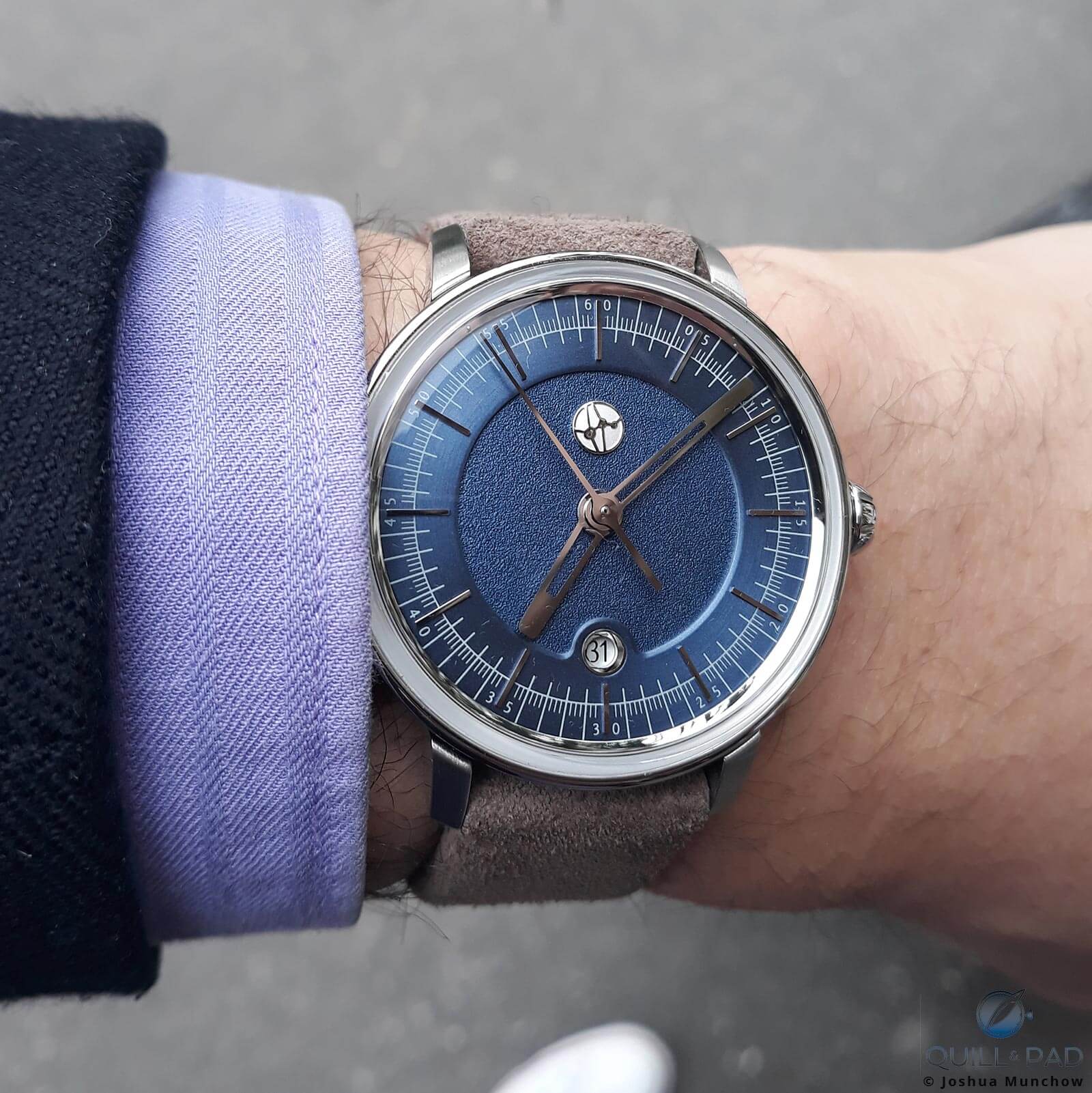
A Lundis Bleus Essentielles collection watch on the wrist
Essentielles’ characteristics are pretty straightforward: layered dials with a mixture of finishes including hammered, brushed, and polished, with applied baton markers and a date window. The date mirrors the logo opposite it on the dial with a round window that flows well with the dial shapes.
Skeletonized hands, a printed minute and seconds track, and multiple color finishes round out the options and set the tone for the brand moving forward.
Lundis Bleus case details
The case details, which are also rather interesting, have become the common factor across all collections.
It begins with a purposeful separation of the lugs from the main case body. These are attached to the case back and a visual gap is created between the lugs and the main case, emphasizing the curves of the case, making the watch feel smaller and more ergonomic.
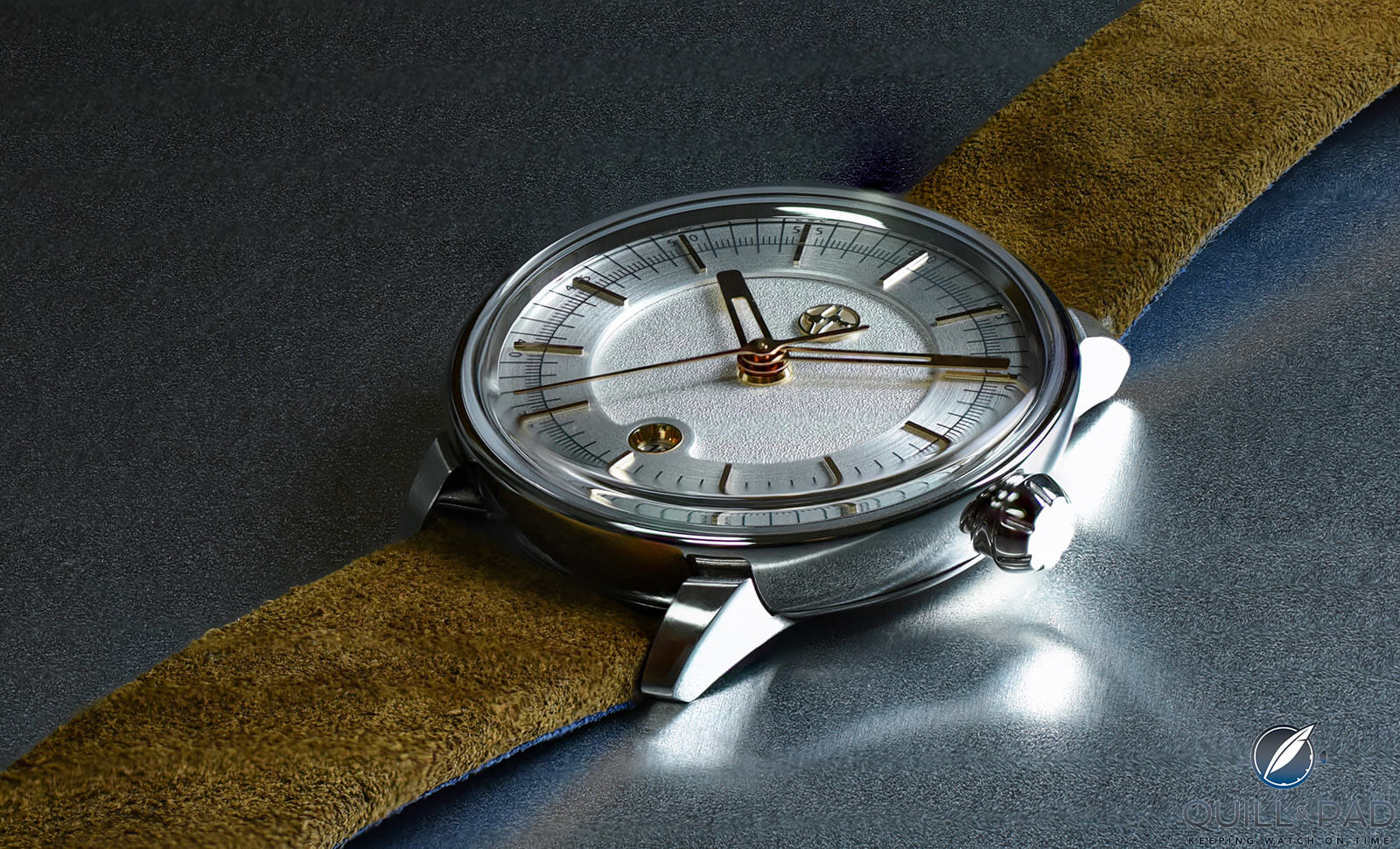
Lundis Bleus Essentielles
While a 40-millimeter diameter isn’t large by any means, this visual cue keeps it from feeling too bulky like other cases can.
There is no bezel ring, either, making the case only two main pieces and simplifying the visual lines we see. This is emphasized with a domed box sapphire crystal that protrudes from the case and rises from an uninterrupted form.
The rear of the case takes another direction altogether with a smaller-than-normal window and a large polished version of the logo bridging the surface as part of the case back.
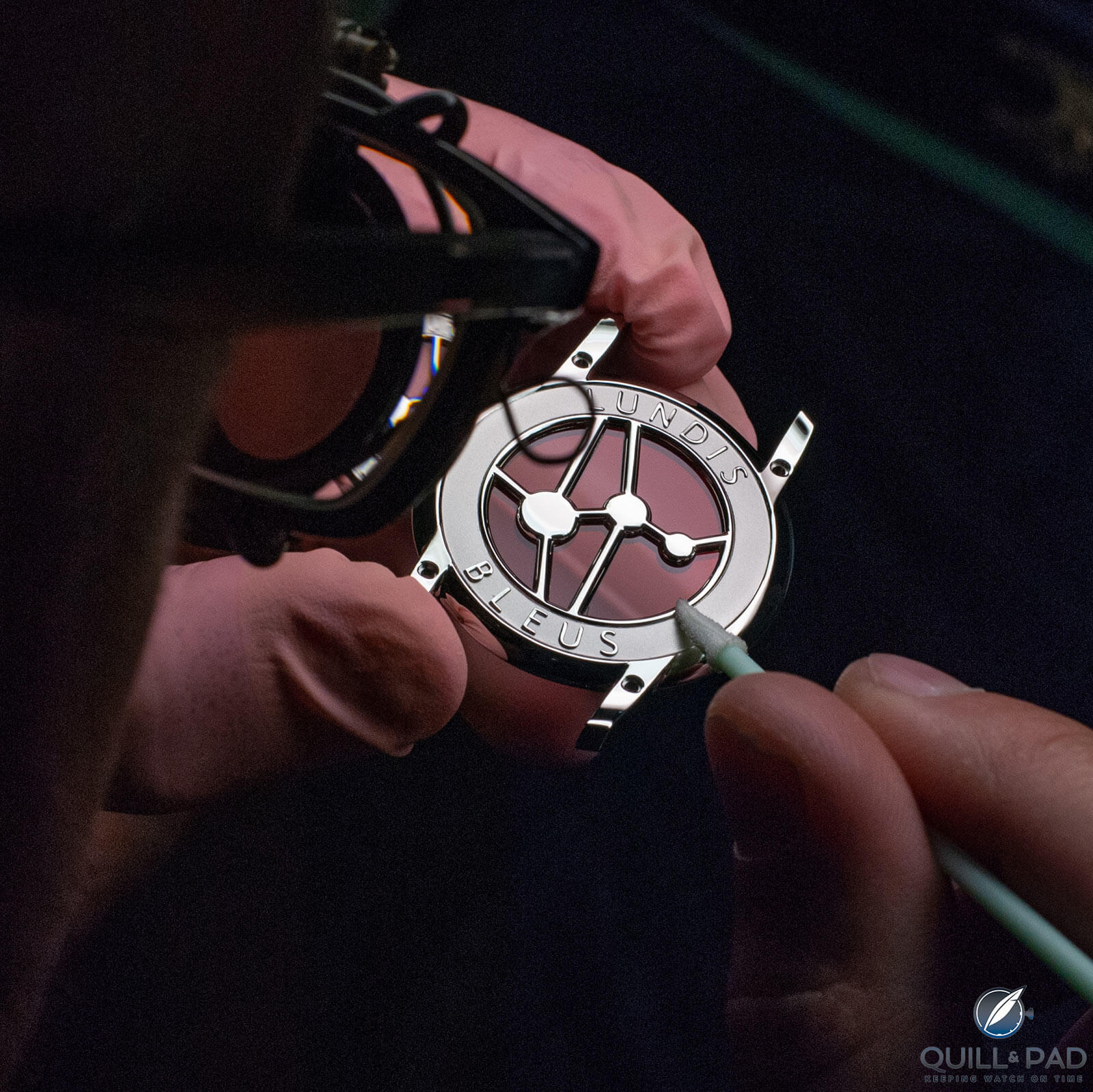
Relief engraved ‘Lundis Bleus’ around the case back bezel
The rear mineral crystal, which is colored, is mounted from the inside and held with a ring, while the entire case back seals the watch closed outside of that ring. This provides a wide section for relief engraving of the brand name around the outside of the crystal.
All of this is standard across the collections and provides a consistent schedule of parts that doesn’t require varieties of part numbers and complicated supply sourcing. That is one huge way to keep costs down while playing with variety limited to dial layouts.
And that brings us to the newer collections, which see the introduction of new dial layouts, materials, and a new Swiss ETA movement for a variety of price points and aesthetic options.
More Lundis Bleus collections
The first step up from the Essentielles collection is the Contemporaines line, which features very modern, simplified dials that come in a variety of in-house high-fire enamel as well as aventurine and onyx (with an attached increase in price).
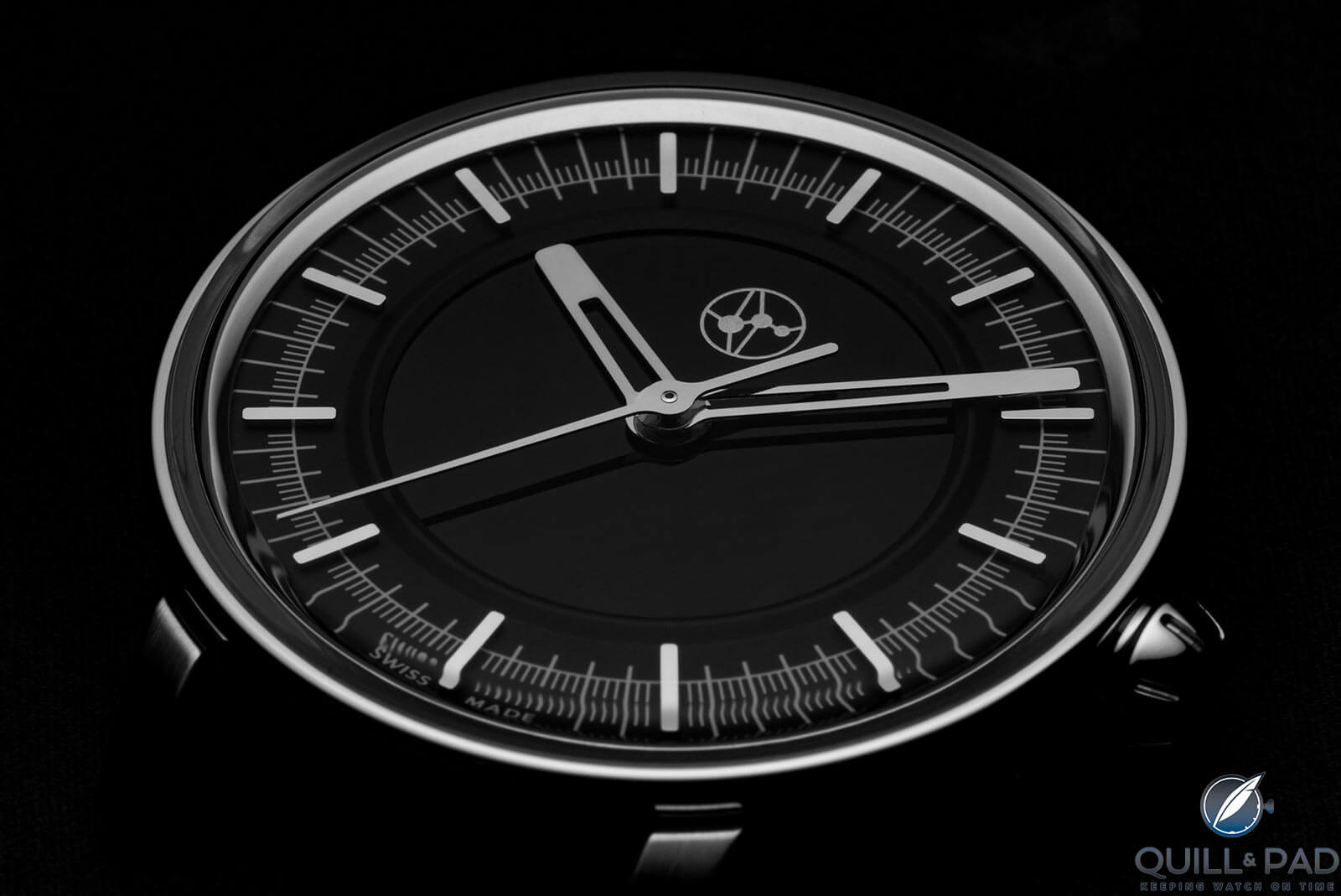
Lundis Bleus Reference 1110 with black dial
While the site only has a few listed, by following Lundis Bleus’ Instagram account you can see that other colors of enamel have been created as well as various other stone options.
Since they do the enameling in-house (I believe it is Vuilliomenet who personally began the development), whatever experimentation they want to do could eventually make it into a unique piece or become a standard color.
The enamel dials aren’t just enamel either, they feature hand-hammered surfaces for increased depth and texture. Further, blue aventurine and polished black onyx add yet another layer of class to the Contemporaines collection.
The enamel dial versions have done away with every dial detail seen in the Essentielles collection, using only slim printed markers, the logo, and the skeletonized hands. The stone dials have absolutely no markers or logo, keeping the surface pristine and dare I say beautiful.
Lundis Bleus collections extended
The next level up from the Contemporaines collection is the Métiers d’Art collection, the first to include a top-grade Swiss ETA 2892 movement – and with a comparable upgrade in pricing.
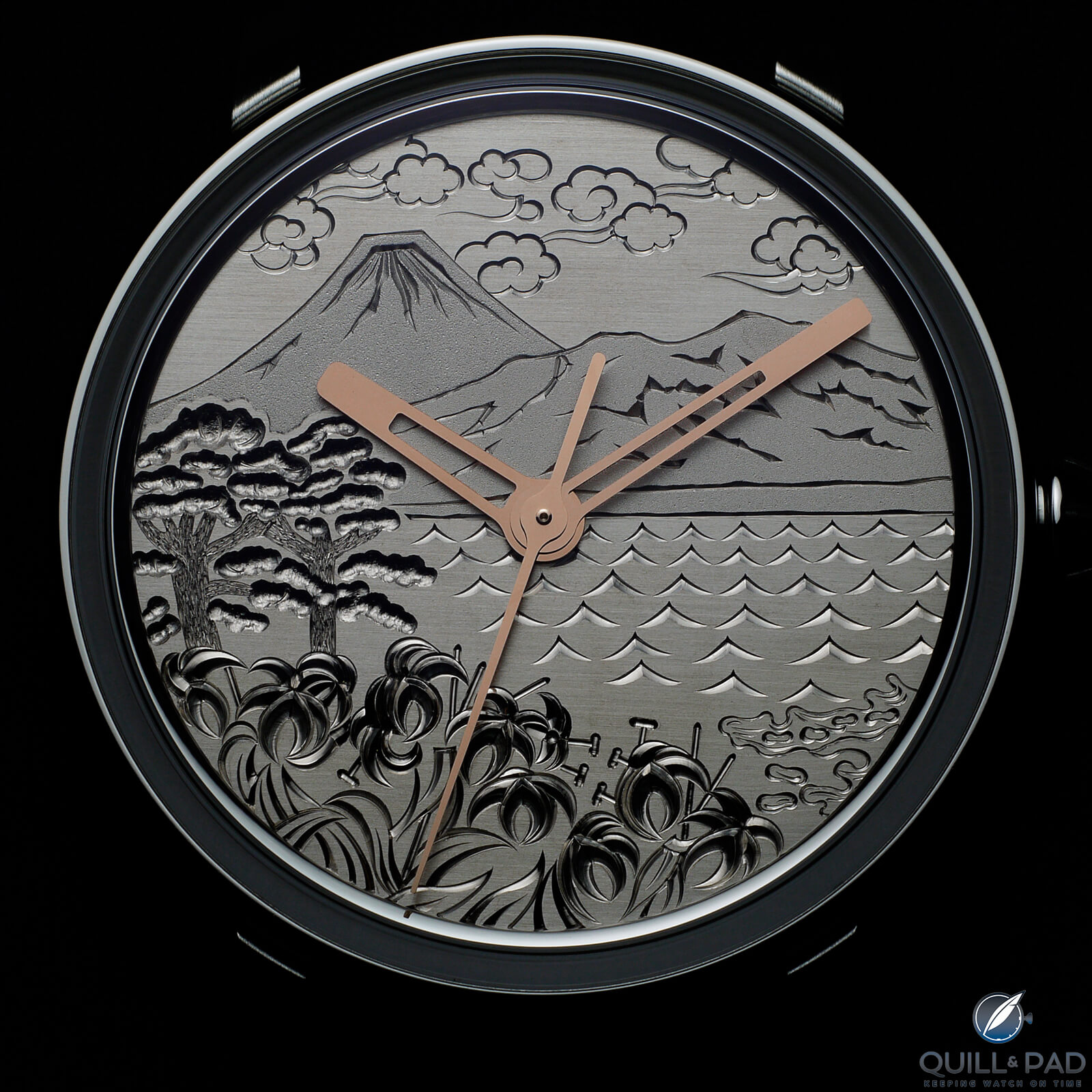
Lundis Bleus Reference 1110 with Métiers d’Art engraved Fujisan dial
Most of the dials in these pieces are similar to the Essentielles with the layered style and applied baton markers, but the dial centers here are where the upgrades become more visible.
The center is no longer just a textured surface, but instead either an engraved enameled finish, or the previously mentioned aventurine or onyx. In the enamel versions, the texture features lines radiating from the center, keeping the two enamel dials visually distinct between collections.
The date window is gone on this model due to the use of enamel and stone dials, simplifying the construction process for those pieces. There is also a fully engraved dial that loses the layers and markers and simply features Japanese-style engraving. This piece isn’t technically limited, but due to the engraved dial being made to order, production will always be limited to orders made.
The final collection is the Contemporaines+, which is basically the same as the Contemporaines but uses the ETA 2892 in place of the Miyota 9015, giving those that still request only Swiss movements for their watches an option.
These come at an added cost over the basic Contemporaines collection, but the Métiers d’Art collection still contains the top-of-the-line pieces from Lundis Bleus.
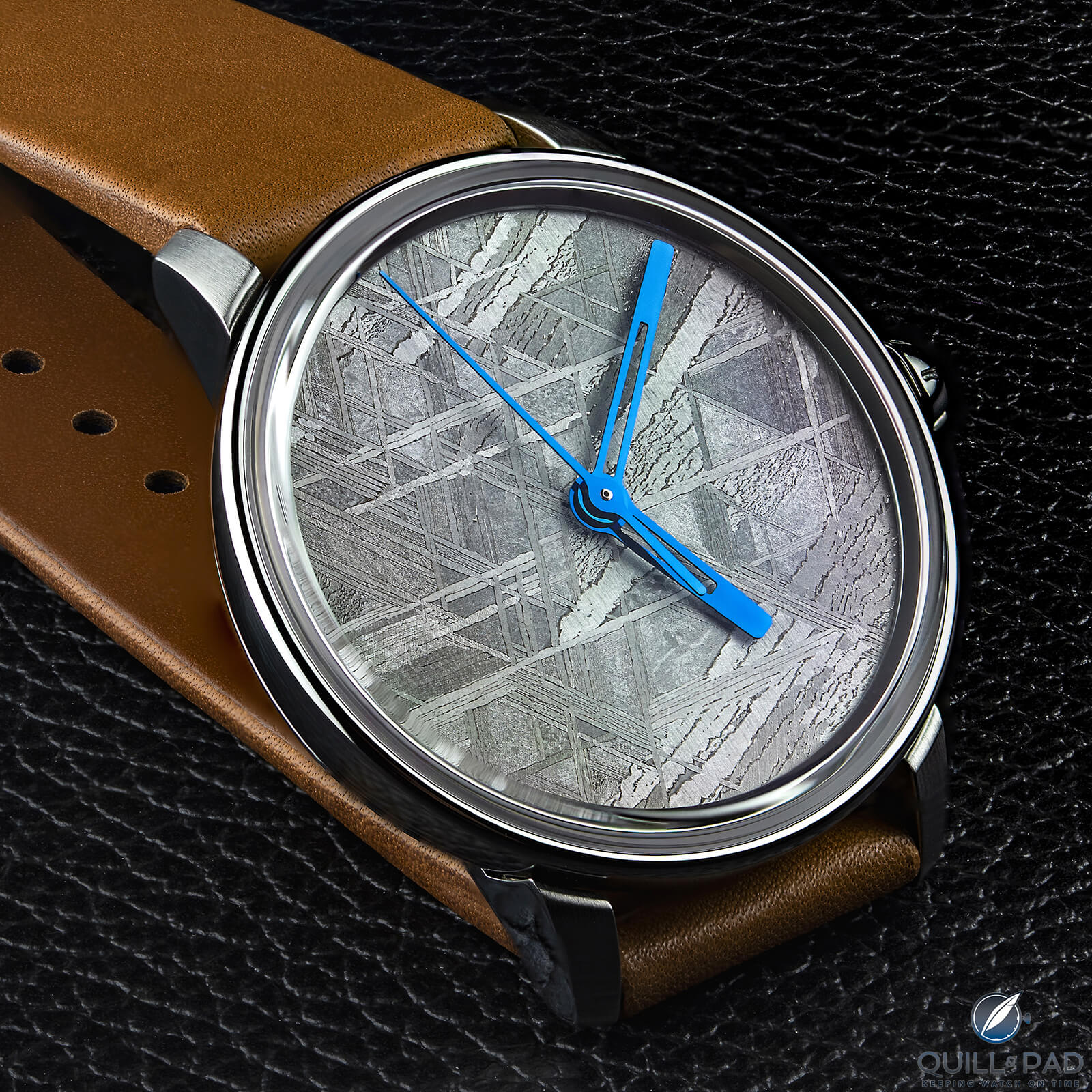
Lundis Bleus Reference 1110 with meteorite dial
The brand is also always adding options to the collections with new stones and enamel finishes such as cloisonné enamel as well as some meteorite dials.
All these fit into the four basic collections, which have provided a solid foundation to build a brand. Further development seems to be going along the lines of what has been created, smartly, I might add, since it parlays previous investments in design and sourcing manufacturing into expanding the brand even more.
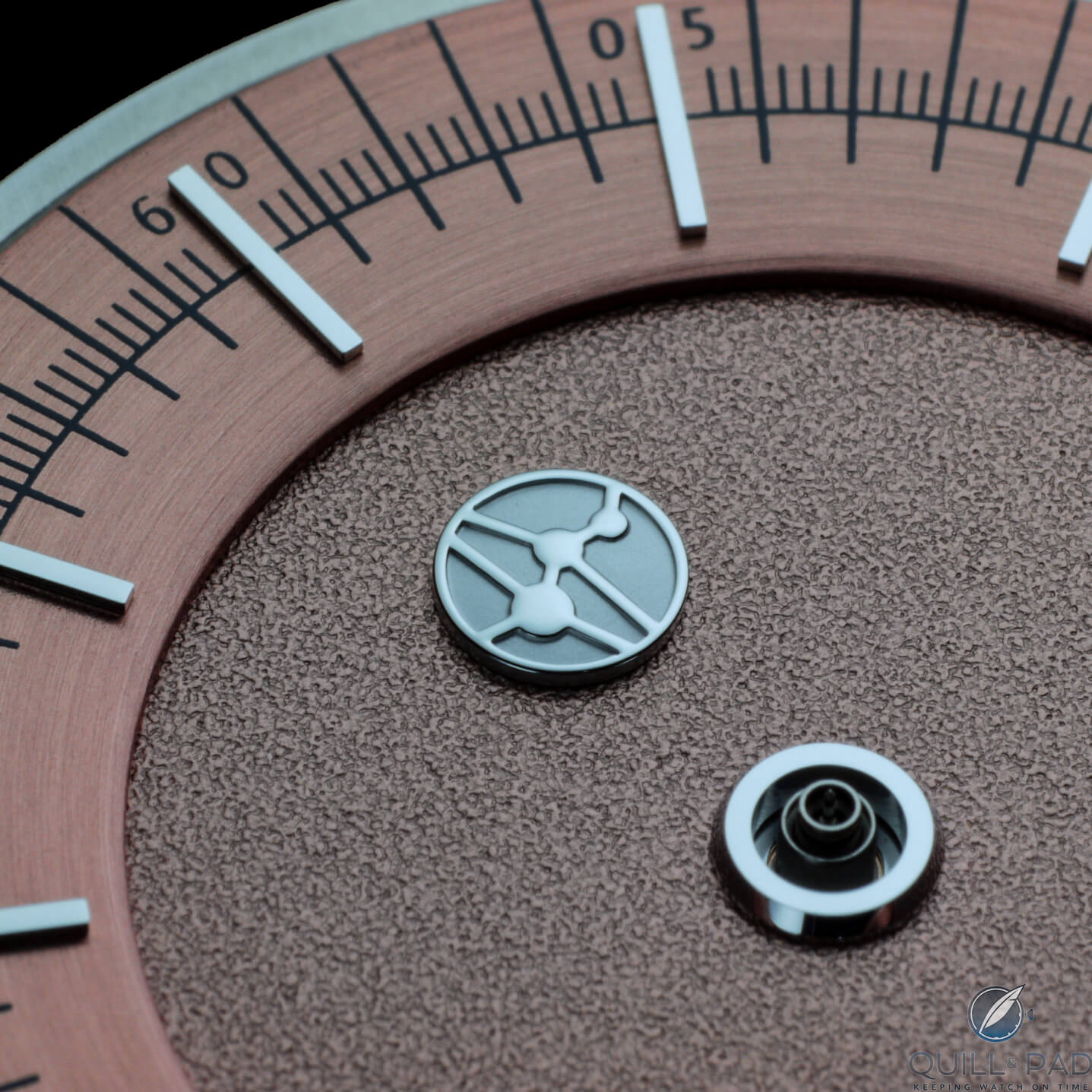
Lundis Bleus dial detail (hands removed)
But what helps to set it apart even more as a young micro brand/independent watchmaker is the addition of a five-year warranty, something that is now becoming popular among the big brands but is still quite rarely seen in small brands due to the possible strain it could put on the minimal resources of the company.
I imagine that the slightly increased cost of the watches relative to comparable pieces on the market helps to cover some of those costs, but the reality of offering such a warranty might help the wary decide to invest in a young company and its timepieces. One of the main complaints that independents (at all levels) hear is that people worry about the longevity of the company and the reliability of service.
Simply being able to provide a quality user experience in the face of product failures would go a long way to making any company a favorite with the customer base. After-sales service and interactions with customers is a huge complaint across the industry, and a young brand making that a priority is a very smart.
I know that from the first time I saw a Lundis Bleus watch online I was sure to become a fan. But after hearing and seeing more, learning about the people behind the brand, and eventually meeting and handling the watches, it was more than just being a fan: I had respect for what Storni and Vuilliomenet have created.
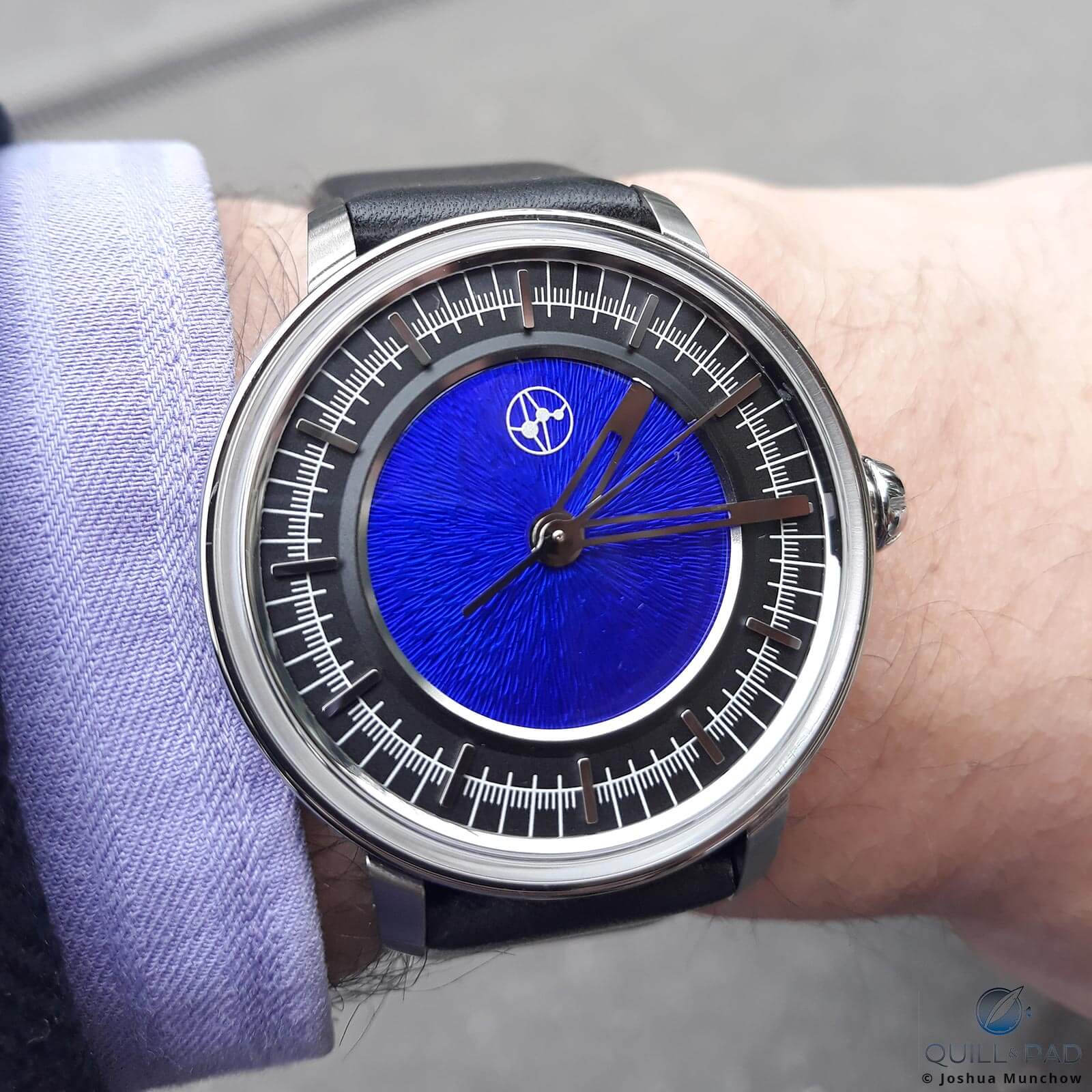
Blue enamel Lundis Bleus Reference 1110 on the wrist
The Lundis Bleus concept and name seemed a bit esoteric, I’ll give you that, but the direction and execution couldn’t be denied. And since I have long given up being a movement or component snob (well, mostly) and no longer hold Swiss made above all the rest, it frees my thoughts to focus on just enjoying what Lundis Bleus has created.
Lundis Bleus definitely comes in at the lower end of the watch spectrum, but the results speak for themselves. I would urge you to seek out opportunities for hands-on time with one of the models.
This is a serious player in the sub-$4,000 price bracket (except for the Japanese-engraved dial version, which exceeds this price range), and I am excited to see what else the two founders might try to expand upon the concept in the future.
For more information, please visit www.lundis-bleus.com and/or www.instagram.com/lundisbleus.
Quick Facts Lundis Bleus
Case: 40 x 11 mm, 316L stainless steel
Movement: automatic Caliber ETA 2892 or Miyota 9015 (depending on collection)
Functions: hours, minutes, seconds; date (where applicable)
Price: 1,900 to 12,000 Swiss francs depending on specific model
You may also enjoy:
Big Brand Investments In Independents: Sellout Or Salvation?
Independent Watchmaking: A New Trend Or Just A Trendy Term
Leave a Reply
Want to join the discussion?Feel free to contribute!





















































What a sensitive and well-written review! About eighteen months ago I purchased the 2019 Anniversary Edition, which was a limited production of only 9 watches. It has turned out to be the favorite watch in my collection and I wear it about 15 days per month. The size and weight are perfect for everyday wear, the case construction is totally unique, and the randomly scratched sterling silver grand feu enamel dial is exquisite! Lundis Bleus is a top quality brand that is the best at what they do and won’t be a “best kept secret” for long.